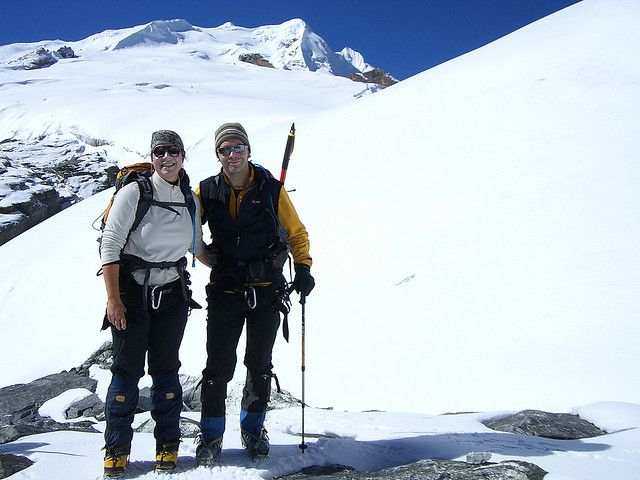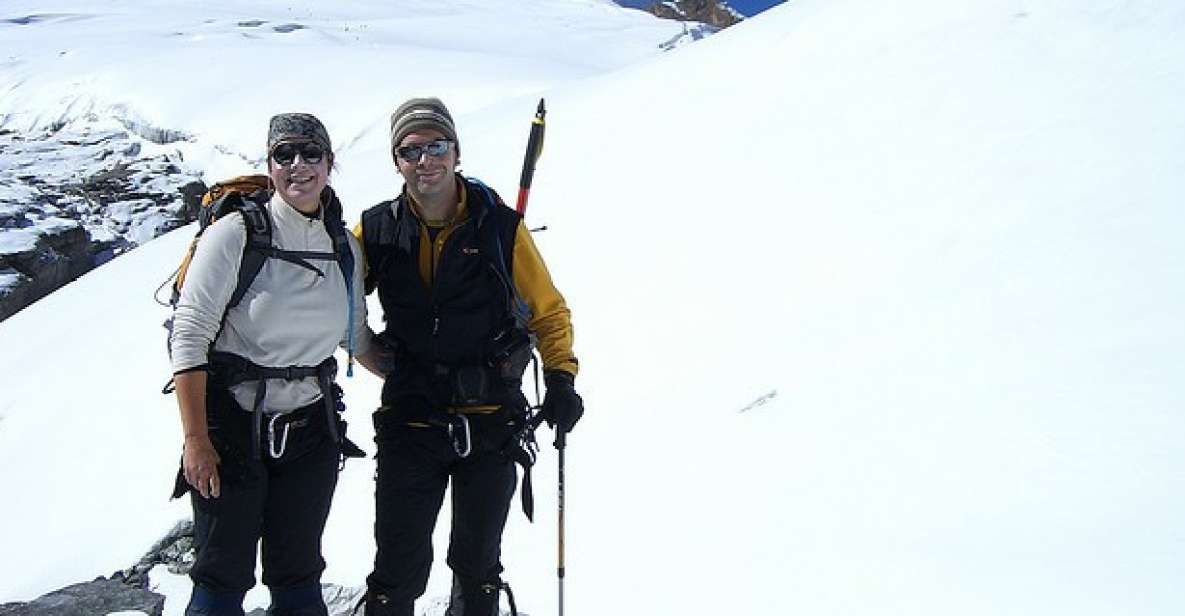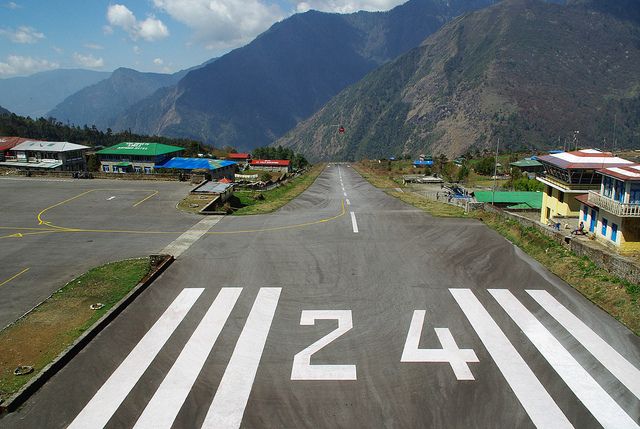Considering a 23-day trek to Mera Peak could be an exhilarating choice for adventurous souls. This expedition isn’t just about reaching the summit; it’s about immersing oneself in the breathtaking landscapes of the Himalayas while ensuring proper acclimatization. With seasoned guides and essential gear at hand, climbers will find this journey both challenging and rewarding. However, understanding the finer details—like pricing, best climbing seasons, and safety measures—can significantly enhance the experience. What aspects should one prioritize to ensure a successful summit attempt?
Key Points

- The Mera Peak climbing adventure lasts 23 days, including acclimatization and a summit attempt at 6,461 meters.
- Prices start from K₨71,737 per group, accommodating up to 20 participants.
- The best climbing seasons are spring (March to May) and autumn (September to November) for optimal weather conditions.
- The package includes airport transfers, accommodation in Kathmandu, meals, guides, and essential gear for climbers.
- Participants must be reasonably fit, aged between 10 and 95, with prior trekking experience preferred.
It's also worth checking out some other tours and experiences nearby.
Overview and Pricing

Mera Peak Climbing offers an exciting 23-day adventure to the highest trekking peak in Nepal, with prices starting from K₨71,737 per group for up to 20 participants.
This thrilling expedition reaches an altitude of 6,461 meters (21,190 feet) and is best undertaken in spring or autumn when weather conditions are most favorable.
Participants can enjoy peace of mind with a free cancellation policy, allowing a full refund if they cancel 24 hours in advance.
Plus, they can reserve their spot now and pay later, making planning easier.
With detailed inclusions covering everything from accommodations to meals and expert guides, it’s a fantastic opportunity for adventurers seeking a memorable experience in the Himalayas.
Detailed Itinerary
The detailed itinerary for this exhilarating 23-day trek is designed to guide adventurers through the stunning landscapes and challenging climbs of Mera Peak, ensuring a well-rounded experience from start to finish.
Day one kicks off with arrival in Kathmandu, followed by trip preparations on day two.
The excitement builds with a flight to Lukla and a trek to Paiya on day three.
Over the next two weeks, trekkers journey through picturesque stops, including Ningsow and Khare, allowing for acclimatization and training.
Summit day is on day twelve, with a strenuous climb back to Khare. A reserve day ensures flexibility.
Inclusions and Benefits

Included in the Mera Peak climbing package are a range of essential services and benefits that ensure a safe and enjoyable experience for all participants.
Travelers can expect airport pickup and drop, plus three nights of hotel accommodation in Kathmandu. Experienced guides and professional porters accompany the group, ensuring safety and support throughout the trek.
Daily meals, including breakfast, lunch, and dinner, keep energy levels high, while necessary permits and first aid kits are provided for peace of mind.
Plus, climbers receive essential gear like sleeping bags and down jackets. To enhance their journey, participants also get a Mera Peak map and an Alpine Club of Himalaya T-shirt, plus a farewell dinner to celebrate their adventure.
Exclusions and Costs
Participants should keep in mind that while many services are covered, there are several exclusions and additional costs they need to plan for during the Mera Peak climbing adventure.
It’s essential to budget for these items to avoid any surprises:
-
Lunch and dinner in Kathmandu (other than the farewell dinner)
-
Personal expenses like snacks, drinks, and tips for guides and porters
-
Travel insurance and any medical expenses, including rescue
Being aware of these exclusions helps ensure a smoother experience.
It’s wise to prepare ahead, factoring in these costs to make the most of the climb without financial stress.
Planning can help participants focus on their adventure instead of worrying about unexpected expenses.
Participant Requirements
Planning for Mera Peak climbing involves understanding participant requirements to ensure everyone is well-prepared for the adventure ahead.
First and foremost, climbers should be at least 10 years old; younger participants aren’t permitted. Participants over 95 years old also can’t join due to safety concerns.
It’s essential that climbers possess a reasonable level of fitness and prior trekking experience, especially at high altitudes. Familiarity with basic climbing techniques is beneficial, but guides will provide training.
Plus, having proper gear is crucial to ensure safety and comfort during the trek.
Lastly, participants should secure travel insurance that covers high-altitude climbing.
Best Climbing Seasons
The ideal times for climbing Mera Peak are during the spring and autumn seasons, when weather conditions are most favorable for a successful ascent.
Spring, from March to May, offers clearer skies and milder temperatures, perfect for climbers. Autumn, from September to November, presents stable weather, making it another excellent choice for adventurers.
Here are a few key considerations:
-
Temperature: Expect comfortable daytime temperatures but be prepared for colder nights.
-
Crowds: Spring tends to attract more climbers, while autumn is quieter but still offers great conditions.
-
Visibility: Both seasons provide stunning panoramic views, enhancing the overall climbing experience.
Choosing the right season can significantly impact the journey to Mera Peak and ensure a memorable adventure.
Safety and Preparation
How can climbers ensure their safety and readiness for the challenges of Mera Peak? Proper preparation is key. Climbers should focus on physical fitness, acclimatization, and essential gear. Below’s a quick guide to help them prepare:
| Preparation Aspect | Details | Tips |
|---|---|---|
| Physical Fitness | Cardio, strength training | Train at higher altitudes |
| Acclimatization | Gradual ascent | Take rest days |
| Gear | High-quality equipment | Test gear beforehand |
| Nutrition | Balanced meals | Stay hydrated |
| Emergency Plans | Rescue protocols | Know evacuation routes |
Booking Information
Climbers looking to conquer Mera Peak can easily secure their spot through a straightforward booking process that offers flexibility and transparency. They can reserve their adventure without needing to make an upfront payment, which is a game-changer for many. Plus, the free cancellation policy ensures peace of mind, allowing for a full refund if plans change with at least 24 hours’ notice.
Here are a few key points about booking:
-
Group Size: Up to 20 participants can join, making it ideal for friends or families.
-
Best Seasons: Spring and autumn provide the most favorable climbing conditions.
-
Inclusive Packages: The trip includes various essential services, ensuring a hassle-free experience.
This makes planning an unforgettable journey much simpler!
Here's a few more nearby tours and experiences we think you'll like.
Frequently Asked Questions
What Physical Fitness Level Is Required for Mera Peak Climbing?
For Mera Peak climbing, participants should be physically fit, regularly hiking or trekking. Cardiovascular endurance, strength training, and acclimatization preparation are crucial. It’s best if climbers can handle long days at high altitudes comfortably.
Are There Any Age Restrictions for Participants?
Yes, there are age restrictions for participants. Children under 10 and babies under 1 can’t join, while individuals over 95 aren’t allowed either. It’s important to ensure safety and suitability for the trek.
What Type of Food Is Served During the Trek?
During the trek, participants enjoy a variety of meals, including breakfast, lunch, and dinner. They’re served hearty, nutritious foods to sustain energy, often featuring local dishes, rice, lentils, and fresh vegetables to fuel their adventure.
Can I Bring My Own Climbing Gear?
He can absolutely bring his own climbing gear. It’s often recommended for comfort and familiarity. However, he should ensure it meets safety standards and consider any specific requirements set by the climbing organization.
Is Altitude Sickness Common During the Climb?
Altitude sickness is indeed common among climbers, especially above 3,000 meters. It’s crucial for participants to acclimatize properly, stay hydrated, and recognize symptoms early. Taking it slow can really help mitigate risks during the climb.
Not for you? Here's more of our most recent tour reviews happening neaby
- 10 Days Nepal and Bhutan Cultural Tour
- Kathmandu Valley 6-Day Cultural Tour and Trekking
- From Kathmandu: 13 Day Poon Hill & Annapurna Base Camp Trek
- Casino Tour in Kathmandu
- Langtang Valley Trek – 10 Days
- Everest High Pass Trek – Nepal
- Kathmandu: Everest Base Camp Kala Patthar 15-Day Trek
- Nepal Spiritual Laughing 14 Day Trekking Program
- Everest Base Camp Helicopter Shared Tour
- Kathmandu: 14-Day Langtang Gosaikunda Trek
- All Package Nepal Annapurna View Trekking & Tour
- Bhutan, “The Land of Thunder Dragon”
- 15 Day Annapurna Circuit Trek From Kathmandu
- Manaslu Circuit Trek Conquer the Majestic
- From Kathmandu :11-Day Guided Manasalu Circuit Trek
Recap
To sum it up, Mera Peak climbing is an exhilarating journey that offers both challenge and breathtaking beauty.
With a well-structured itinerary, experienced guides, and a focus on safety, adventurers are sure to have an unforgettable experience.
By preparing adequately and choosing the right climbing season, participants can maximize their chances of reaching the summit.
So, if you’re ready to take on this incredible adventure, gather your gear and get ready for an unforgettable trek to the top of Nepal!
